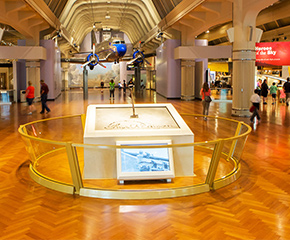"Oliver Evans' 'Oructor Amphibolis,' or, Amphibious Digger, the First American Locomotive--1804"
Add to SetSummary
Inventor and engineer Oliver Evans believed that steam engines, used to power mills and steamboats, could also propel land vehicles. An opportunity to experiment came with a commission from the Philadelphia Board of Health for a steam dredge. Evans designed a 30-foot-long, 17-ton amphibious digger that moved successfully over land in 1805. This one-time stunt proved the viability of steam-powered carriages.
Inventor and engineer Oliver Evans believed that steam engines, used to power mills and steamboats, could also propel land vehicles. An opportunity to experiment came with a commission from the Philadelphia Board of Health for a steam dredge. Evans designed a 30-foot-long, 17-ton amphibious digger that moved successfully over land in 1805. This one-time stunt proved the viability of steam-powered carriages.
Artifact
Photographic print
Subject Date
1804
Keywords
Collection Title
On Exhibit
By Request in the Benson Ford Research Center
Object ID
42.379.1
Material
Paper (Fiber product)
Technique
Gelatin silver process
Color
Black-and-white (Colors)
Dimensions
Height: 4.5 in
Width: 5.625 in
Inscriptions
on front: OLIVER EVANS' "ORUCTOR AMPHIBOLIS," OR AMPHIBIOUS DIGGER. / THE FIRST AMERICAN LOCOMOTIVE-- 1804





